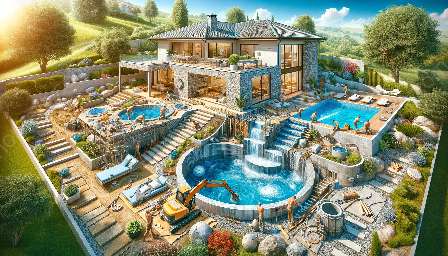Spa plumbing and drainage are crucial aspects of spa construction and the broader field of swimming pools & spas. This comprehensive guide explores the complexities of spa plumbing and drainage, understanding the essential components, maintenance, and integration with spa construction.
Understanding Spa Plumbing
Spa plumbing encompasses the intricate network of pipes, valves, and fittings that facilitate the circulation, filtration, and heating of water within the spa system. Critical components of spa plumbing include:
- Pipes: PVC, CPVC, or flexible PVC pipes are commonly used in spa plumbing due to their resistance to chemical and temperature fluctuations.
- Valves and Fittings: These components regulate the flow of water and allow for adjustments to the system's pressure, ensuring optimal performance.
- Pumps and Motors: These provide the necessary force to circulate water through the spa's plumbing system, supporting filtration and heating processes.
Key Considerations in Spa Plumbing Design
When designing the plumbing system for a spa, several critical considerations must be taken into account to ensure efficient and reliable operation:
- Hydraulic Efficiency: Proper pipe sizing, valve placement, and pump selection are essential for achieving optimal hydraulic performance and energy efficiency.
- Backflow Prevention: Installing anti-siphon and check valves helps prevent water contamination and maintain water quality in the spa.
- Pressure Regulation: Control systems and pressure relief valves are essential for managing water pressure and protecting the spa's plumbing components.
Drainage Systems for Spas
Effective drainage systems are integral to spa construction, ensuring the efficient removal of water and preventing water damage or flooding. Key elements of spa drainage systems include:
- Drain Fittings: These components facilitate the transfer of water from the spa to the drainage system and may include anti-entrapment grates for safety.
- Overflow Systems: Integral to preventing water overflow, these features help maintain the spa's water level within safe limits.
- Gravity Drainage: Gravity-driven systems utilize downward slopes to direct water away from the spa, often leading to designated drainage areas or sewer connections.
Maintenance and Troubleshooting
Regular maintenance and prompt troubleshooting are essential to ensure the longevity and performance of spa plumbing and drainage systems. Key maintenance tasks include:
- Inspection and Cleaning: Regular inspection of pipes, filters, and drainage outlets is crucial to identify and address potential blockages or leaks.
- Chemical Balancing: Proper water chemistry management is vital to prevent corrosion of plumbing components and maintain water clarity.
- Leak Detection: Monitoring for leaks and addressing them promptly helps prevent water damage and supports the efficient operation of the spa.
Integration with Spa Construction and Swimming Pools & Spas
Spa plumbing and drainage are integral aspects of spa construction and are closely related to swimming pools & spas. Their integration involves:
- Design Coordination: Coordinating the placement and design of plumbing and drainage systems with the overall spa construction and swimming pools & spas layout to ensure seamless integration.
- Efficient Water Management: Ensuring that the plumbing and drainage systems are optimized for water conservation and efficient water circulation, aligning with sustainable practices and regulations.
- Safety and Compliance: Adhering to industry standards and regulations in the design and installation of spa plumbing and drainage systems to prioritize safety and compliance.


